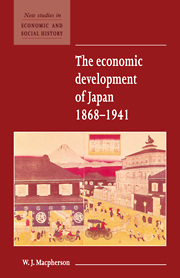Book contents
- Frontmatter
- Contents
- List of tables
- Notes on references
- Preface
- 1 Introduction
- 2 Growth and structural change
- 3 The Tokugawa background (c. 1600–1860)
- 4 The role of the state
- 5 Factors in demand
- 6 Land and agriculture
- 7 Labour supply and the labour market
- 8 Capital, technology and enterprise
- 9 Conclusion
- Bibliography
- Bibliographical update
- Updated bibliography
- Index
- New Studies in Economic and Social History
9 - Conclusion
Published online by Cambridge University Press: 11 January 2010
- Frontmatter
- Contents
- List of tables
- Notes on references
- Preface
- 1 Introduction
- 2 Growth and structural change
- 3 The Tokugawa background (c. 1600–1860)
- 4 The role of the state
- 5 Factors in demand
- 6 Land and agriculture
- 7 Labour supply and the labour market
- 8 Capital, technology and enterprise
- 9 Conclusion
- Bibliography
- Bibliographical update
- Updated bibliography
- Index
- New Studies in Economic and Social History
Summary
Despite the abundance of statistics and interpretations, explanations of how Japan ‘did it’ remain elusive. Growth was a function of a large number of peculiar interacting non-economic and economic factors, all of which were necessary conditions but none alone sufficient. We find elements of both the Weberian syndrome where the ethos determines the economy and of the Marxist where material conditions influence society. Two fundamental conditions for modern economic growth were the ‘Tokugawa legacy’ and the role of the government. The contribution of the former in the socio-cultural fields, in attitudes to thrift, diligence and loyalty, has long been recognised, but it is only in recent years that the extent of economic development before 1868 is becoming fully appreciated. The role of the government was crucial, not so much in terms of pioneering industries and taxes and subsidies, but in its moulding of society to conform to its military and therefore economic objectives. Toynbee's concept of challenge and response is illuminating. Perry's black ships symbolise the challenge of possible western colonisation. The response was not to withdraw further into an isolationist posture but to emulate and catch up with the West. This required both a radical transformation of some socio-economic institutions and the strengthening of traditional nationalistic values through state Shintoism and educational propaganda. Political independence enabled Japan to control some of the potentially damaging aspects of western modernisation and to indulge in eclecticism in borrowing from abroad. Compared with, say, India, the relative homogeneity of language and society facilitated state direction.
- Type
- Chapter
- Information
- The Economic Development of Japan 1868–1941 , pp. 70 - 71Publisher: Cambridge University PressPrint publication year: 1995



